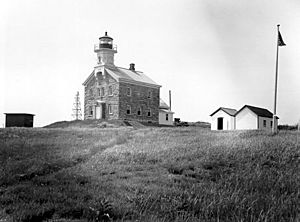Plum Island Light facts for kids
 |
|
| Lighthouse on Plum Island | |
|
|
|
| Location | Plum Island (New York) |
|---|---|
| Coordinates | 41°10′25.20″N 72°12′41.47″W / 41.1736667°N 72.2115194°W |
| Year first lit | 1827 |
| Automated | 1978 |
| Construction | second light on granite house (1869) metal tower (1978) |
| Height | 50 feet (15 m) from sea level |
| Original lens | 10 whale oil lamps (1827) Sixth-order fresnel (1856) Fourth-order fresnel (1897) Automated flash (1978) |
| Range | 5 nautical miles (9.3 km) |
| Characteristic | 2.5 second White flash |
| ARLHS number | USA-606 |
| USCG number | 1-21090 |
The Plum Island Light is a historic lighthouse found on the western tip of Plum Island. This island is located east of Orient Point in New York State, at the very end of Long Island's North Fork.
An old granite lighthouse, built in 1869, stands at the site. However, it no longer guides ships. This building was added to the National Register of Historic Places in 2011. A short distance away, a 14 feet (4.3 m) metal tower holds the modern, automated light. This newer light has been guiding ships since 1978, when the older light was turned off.
Contents
Building the First Lighthouse
In 1826, the western part of Plum Island was bought for $90. The goal was to build a lighthouse there. The very next year, a 35 feet (11 m) tall stone tower was finished. This tower held the first light.
Early Light Technology
The first light used ten whale oil lamps with special reflectors. This light helped ships navigate safely. It was especially useful near the entrance to Long Island Sound. It also guided ships through a narrow channel called "Plum Gut" between Orient Point and Plum Island. In 1856, the old lamps were replaced. A newer, more advanced Fresnel lens (a type of special lens for lighthouses) was installed.
The Second Lighthouse
By the late 1860s, the first lighthouse was getting old and needed repairs. So, a new, taller granite lighthouse was built. This new building was 55-foot (17 m) tall and started working in 1869.
Similar Lighthouse Designs
This new lighthouse was designed like several others built around the same time. You can see similar lighthouses at Sheffield Island in Norwalk, Connecticut, Morgan Point in Noank, Connecticut, and Great Captain Island in Greenwich, Connecticut. Other similar ones include Old Field Point in Old Field, New York, and Block Island North on Block Island. The Fresnel lens from the first lighthouse was moved to this new building. Later, in 1897, it was updated to an even newer, more powerful lens.
Lighthouse Keepers and Fort Terry
In 1897, a military base called Fort Terry was built on Plum Island. For many years, the lighthouse keepers and army soldiers got along well. The keepers could even buy food and supplies from the Fort's store.
A Rule Change
However, in 1916, a new rule came out. The lighthouse keeper at Plum Island Light was told he could no longer buy supplies at Fort Terry. This rule made things difficult for William Chapel, who was the keeper at the time. He had to sail over a mile to Orient or 12 miles to New London just to get supplies. Luckily, the United States Lighthouse Service eventually convinced the Army to change the rule. Lighthouse keepers were once again allowed to buy supplies at army stores.
Modern Changes to the Light
In 1939, the United States Coast Guard took over the job of running lighthouses. Coast Guard keepers worked at Plum Island until 1978. That year, the light was automated. This means it no longer needed a person to operate it. A new structure was built next to the 1869 lighthouse to hold the automated light.
The Lens Moves to a Museum
In 1994, the old Fresnel lens was taken out of the lighthouse. It was moved to the East End Seaport Museum in Greenport. You can see it on display there today.
Future of the Lighthouse
Since 2000, a group called East End Lighthouses has been working to restore the Plum Island Light. They hope to eventually turn it back on as an active light for ships. In 2007, the town of Southold passed a resolution. This means the town plans to take ownership of the lighthouse.
Visiting the Lighthouse
The Plum Island Lighthouse is not usually open to the public. Only special groups can sometimes get permission to visit Plum Island. This is because the United States Department of Homeland Security controls access. You can see the light from the water, but landing on the island is restricted. Only people with official business at the Plum Island Animal Disease Center are allowed to go ashore.
Cultural Connections
The Smithsonian National Museum of American History has a collection of old postcards featuring lighthouses. They have put many of these online, including postcards of Plum Island Light. These online postcards even link to special nautical charts provided by the National Oceanic and Atmospheric Administration.



